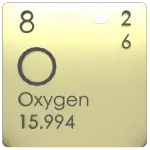About Aerogel
Aerogel is a synthetic porous ultralight solid material derived from a gel, in which the liquid component of the gel has been replaced with a gas (during a supercritical drying process). Aerogels can be made from a variety of chemical compounds, but the base material for aerogel is usually silicon.
Summary
| Name | Aerogel |
| Phase at STP | solid |
| Density | 10 kg/m3 |
| Ultimate Tensile Strength | 0.08 MPa |
| Yield Strength | N/A |
| Young’s Modulus of Elasticity | 0.005 GPa |
| Brinell Hardness | N/A |
| Melting Point | 1197 °C |
| Thermal Conductivity | 0.01 W/mK |
| Heat Capacity | 1900 J/g K |
| Price | 12 $/kg |
Composition of Aerogel
Silica aerogel is the most common type of aerogel, and the most extensively studied and used. It is silica-based and can be derived from silica gel or by a modified Stober process. Carbon aerogels are composed of particles with sizes in the nanometer range, covalently bonded together.
Applications of Aerogel

Aerogel has a very low thermal conductivity of 0.013 W/m∙K. Its density is also very low, about 150 kg/m3. These are remarkable thermal insulative properties. It must be noted, aerogels may have lower thermal conductivity than that of the gas (air has about 0.025 W/m∙K) they contain. This is caused by the Knudsen effect, a reduction of thermal conductivity in gases when the size of the cavity encompassing the gas becomes comparable to the mean free path. In 2004 about US$25 million of aerogel insulation product were sold, which had risen to about US$500 million by 2013. This represents the most substantial economic impact of these materials today. The potential to replace conventional insulation with aerogel solutions in the building and construction sector as well as in industrial insulation is quite significant. NASA used an aerogel to trap space dust particles aboard the Stardust spacecraft.
Mechanical Properties of Aerogel
Strength of Aerogel
In mechanics of materials, the strength of a material is its ability to withstand an applied load without failure or plastic deformation. Strength of materials basically considers the relationship between the external loads applied to a material and the resulting deformation or change in material dimensions. In designing structures and machines, it is important to consider these factors, in order that the material selected will have adequate strength to resist applied loads or forces and retain its original shape.
Strength of a material is its ability to withstand this applied load without failure or plastic deformation. For tensile stress, the capacity of a material or structure to withstand loads tending to elongate is known as ultimate tensile strength (UTS). Yield strength or yield stress is the material property defined as the stress at which a material begins to deform plastically whereas yield point is the point where nonlinear (elastic + plastic) deformation begins. In case of tensional stress of a uniform bar (stress-strain curve), the Hooke’s law describes behaviour of a bar in the elastic region. The Young’s modulus of elasticity is the elastic modulus for tensile and compressive stress in the linear elasticity regime of a uniaxial deformation and is usually assessed by tensile tests.
See also: Strength of Materials
Ultimate Tensile Strength of Aerogel
Ultimate tensile strength of Aerogel is 0.08 MPa.
Yield Strength of Aerogel
Yield strength of Aerogel is N/A.
Modulus of Elasticity of Aerogel
The Young’s modulus of elasticity of Aerogel is 0.005 GPa.
Hardness of Aerogel
In materials science, hardness is the ability to withstand surface indentation (localized plastic deformation) and scratching. Brinell hardness test is one of indentation hardness tests, that has been developed for hardness testing. In Brinell tests, a hard, spherical indenter is forced under a specific load into the surface of the metal to be tested.
The Brinell hardness number (HB) is the load divided by the surface area of the indentation. The diameter of the impression is measured with a microscope with a superimposed scale. The Brinell hardness number is computed from the equation:
Brinell hardness of Aerogel is approximately N/A.
See also: Hardness of Materials
Thermal Properties of Aerogel
Aerogel – Melting Point
Melting point of Aerogel is 1197 °C.
Note that, these points are associated with the standard atmospheric pressure. In general, melting is a phase change of a substance from the solid to the liquid phase. The melting point of a substance is the temperature at which this phase change occurs. The melting point also defines a condition in which the solid and liquid can exist in equilibrium. For various chemical compounds and alloys, it is difficult to define the melting point, since they are usually a mixture of various chemical elements.
Aerogel – Thermal Conductivity
Thermal conductivity of Aerogel is 0.01 W/(m·K).
The heat transfer characteristics of a solid material are measured by a property called the thermal conductivity, k (or λ), measured in W/m.K. It is a measure of a substance’s ability to transfer heat through a material by conduction. Note that Fourier’s law applies for all matter, regardless of its state (solid, liquid, or gas), therefore, it is also defined for liquids and gases.
The thermal conductivity of most liquids and solids varies with temperature. For vapors, it also depends upon pressure. In general:
Most materials are very nearly homogeneous, therefore we can usually write k = k (T). Similar definitions are associated with thermal conductivities in the y- and z-directions (ky, kz), but for an isotropic material the thermal conductivity is independent of the direction of transfer, kx = ky = kz = k.
Aerogel – Specific Heat
Specific heat of Aerogel is 1900 J/g K.
Specific heat, or specific heat capacity, is a property related to internal energy that is very important in thermodynamics. The intensive properties cv and cp are defined for pure, simple compressible substances as partial derivatives of the internal energy u(T, v) and enthalpy h(T, p), respectively:
where the subscripts v and p denote the variables held fixed during differentiation. The properties cv and cp are referred to as specific heats (or heat capacities) because under certain special conditions they relate the temperature change of a system to the amount of energy added by heat transfer. Their SI units are J/kg K or J/mol K.
Properties and prices of other materials
material-table-in-8k-resolution










